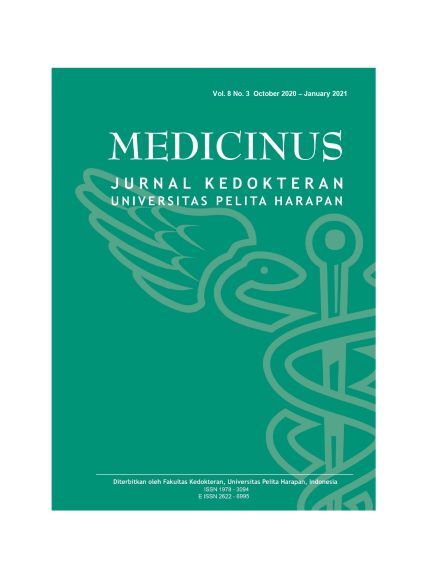Profile and Factors Associated with Depression, Anxiety, and Stress in Indonesian People During COVID-19 Pandemic
DOI:
https://doi.org/10.19166/med.v8i3.3770Keywords:
anxiety, covid-19, depression, stressAbstract
Background : As a result of the COVID-19 pandemic, Indonesia implemented various policies to break the chain of transmission of COVID-19, starting from large-scale social restrictions, quarantines, and even lockdowns. Without exception, schools were also closed. These conditions affect people psychologically, including levels of depression, anxiety, and stress in students. The aim of this study is to determine profile and factors associated with depression, anxiety, and stress in Indonesian people during the COVID-19 pandemic.
Methods : A cross-sectional study among students in Indonesia was conducted to determine depression, anxiety, and stress levels in adolescents based on their sociodemographic characters. The DASS-21 questionnaire was distributed online.
Results : A total of 913 people participated from all provinces in Indonesia. Depression, anxiety, and stress were found in 43.5%, 43.3%, 25.2%, respectively. The severity of depression was significantly associated with age (p<0.001), gender(p=0.003), and region(p=0.039). Adults (25-55) are 4.6 times odds more likely to have depression than adolescent during pandemic (OR=4.641, 95% CI=2.053-10.491). The severity of anxiety was significantly associated with age (p=0.002), gender(p<0.001), education (p=0.004) and region(p=0.004). The severity of stress was significantly associated with gender (p<0.001) and education (p=0.018).
Conclusion : Depression, anxiety and stress quite common found in Indonesian during COVID-19 pandemic. Several sociodemographic factors were associated with depression, anxiety and stress among Indonesia
References
- Bergman S. Treatment of Coronavirus Disease 2019 (COVID-19): Investigational Drugs and Other Therapies. 2020 [cited 2020Oct2]. Available from: https://emedicine.medscape.com/article/2500116-overview
- World health Organization. Timeline: WHO's COVID-19 response. World Health Organization. 2021 [cited 2021Feb24]. Available from: https://www.who.int/emergencies/diseases/novel-coronavirus-2019/interactive-timeline?gclid=Cj0KCQiAj9iBBhCJARIsAE9qRtD9pAMkq7NlpyxuQ-fc0IWCZge_4883JGc1xE3dH1TFX6FYf3an8MUaAm1ZEALw_wcB#!
- Jin Y, Yang H, Ji W, Wu W, Chen S, Zhang W, et al. Virology, Epidemiology, Pathogenesis, and Control of COVID-19. Viruses. 2020;12(4):372. https://doi.org/10.3390/v12040372
- Susilo A, Rumende CM, Pitoyo CW, Santoso WD, Yulianti M, Herikurniawan H, et al. Coronavirus Disease 2019: Tinjauan Literatur Terkini. Jurnal Penyakit Dalam Indonesia. 2020; 7(1):45-6. https://doi.org/10.7454/jpdi.v7i1.415
- Satgas Penanganan COVID. Peta Sebaran. 2020 [cited 2020Sep25]. Available from: https://covid19.go.id/peta-sebaran
- World Health Organization. Coronavirus Disease 2019 (COVID-19) Situation Report - 1. World Health Organization. 2020 [cited 2021Feb24]. Available from: https://www.who.int/docs/default-source/searo/indonesia/covid19/who-indonesia-situation-report-1.pdf?sfvrsn=6be5b359_0
- GTK - oleh S. Pendidikan Era New Normal: Belajar Dari Study from Home. DIREKTORAT JENDERAL GTK. 1970 [cited 2021Feb24]. Available from: https://gtk.kemdikbud.go.id/read-news/pendidikan-era-new-normal-belajar-dari-study-from-home
- Zhang C, Ye M, Fu Y, Yang M, Luo F, Yuan J, et al. The Psychological Impact of the COVID-19 Pandemic on Teenagers in China. Journal of Adolescent Health. 2020;67(6):747-55.
https://doi.org/10.1016/j.jadohealth.2020.08.026 - Psychology Foundation of Australia. Overview of the DASS and its uses. 2018 [cited 2021Feb24]. Available from: http://www2.psy.unsw.edu.au/dass/over.htm
- Thomas J, Barbato M, Verlinden M, Gaspar C, Moussa M, Ghorayeb J, Menon A, Figueiras MJ, Arora T and Bentall RP (2020) Psychosocial Correlates of Depression and Anxiety in the United Arab Emirates During the COVID-19 Pandemic. Front. Psychiatry 11:564172. https://doi.org/10.3389/fpsyt.2020.564172
- Nwachukwu I, Nkire N, Shalaby R, Hrabok M, Vuong W, Gusnowski A, Surood S, Urichuk L, Greenshaw AJ, Agyapong VIO. COVID-19 Pandemic: Age-Related Differences in Measures of Stress, Anxiety and Depression in Canada. Int J Environ Res Public Health. 2020 Sep 1;17(17):6366. PMID: 32882922; PMCID: PMC7503671.
https://doi.org/10.3390/ijerph17176366 - Hou, F., Bi, F., Jiao, R. et al. Gender differences of depression and anxiety among social media users during the COVID-19 outbreak in China:a cross-sectional study. BMC Public Health 20, 1648 (2020). https://doi.org/10.1186/s12889-020-09738-7
- Halim DA, Kurniawan A, Agung FA, Angelina S, Jodhinata C, Winata S. Understanding of young people about COVID-19 during early outbreak in Indonesia. Asian Pacific Journal of Public Health 2020; 32(6-7): 363-5.
https://doi.org/10.1177/1010539520940933
Downloads
Published
How to Cite
Issue
Section
License
Copyright (c) 2021 Teresa Mika Argo, Andree Kurniawan, Jean Andrina Liem, Jeremy Octavian Sugianto, Rafael Jonathan Michael, Nathania Victoria Stevina Tanuwijaya, Lisa Agatha, Beverley Wonsono, Dwi Savitri Rivami

This work is licensed under a Creative Commons Attribution-ShareAlike 4.0 International License.
Authors who publish with this journal agree to the following terms:
1) Authors retain copyright and grant the journal right of first publication with the work simultaneously licensed under a Creative Commons Attribution License (CC-BY-SA 4.0) that allows others to share the work with an acknowledgement of the work's authorship and initial publication in this journal.
2) Authors are able to enter into separate, additional contractual arrangements for the non-exclusive distribution of the journal's published version of the work (e.g., post it to an institutional repository or publish it in a book), with an acknowledgement of its initial publication in this journal.
3) Authors are permitted and encouraged to post their work online (e.g., in institutional repositories or on their website). The final published PDF should be used and bibliographic details that credit the publication in this journal should be included.





